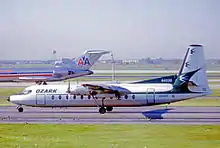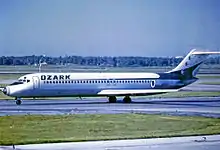Ozark Air Lines
Ozark Air Lines was an airline that operated in the United States from 1950 until 1986 when it was purchased by Trans World Airlines (TWA). In 2001 TWA was merged into American Airlines. A smaller regional airline that used the Ozark name (and whose operating certificate was purchased by Great Plains Airlines) operated in 2000–2001. From 1950 until 1986 Ozark's headquarters was located at St. Louis Lambert International Airport.[1]
 | |||||||
| |||||||
| Founded | September 25, 1950 | ||||||
|---|---|---|---|---|---|---|---|
| Ceased operations | October 26, 1986 (integrated into Trans World Airlines) In 2001 TWA was merged into American Airlines | ||||||
| Hubs | St. Louis | ||||||
| Fleet size | 50 | ||||||
| Destinations | Ozark Mainline cities: 57 Ozark Midwest cities: 21 | ||||||
| Parent company | Ozark Holdings, Inc. | ||||||
| Headquarters | St. Louis County, Missouri | ||||||
| Key people |
| ||||||
History


On 1 September 1943 Ozark Air Lines was founded to fly services from Springfield, Missouri,[2] and in January 1945 it began flights between Springfield and St. Louis on Beech 17 Staggerwings, replaced by Cessna AT-17 Bobcat in the late 1940s. The required license from the Civil Aeronautics Board was not forthcoming and operations had to stop.
In July 1950 Ozark was granted a certificate to operate Parks Air Transport routes not previously activated. Services were started on 26 September 1950 using Douglas DC-3s from St. Louis to Chicago, Tulsa and Memphis.[2] In 1955 the airline had 13 DC-3s flying to 35 cities between Sioux City, Indianapolis, Wichita, and Nashville. Ozark's main hub was St. Louis Lambert International Airport. Like other Local Service airlines, it was subsidized; in 1962 its operating "revenues" of $14.0 million included $4.5 million of federal subsidy.[3]
In 1960 turboprop Fairchild F-27s were introduced; piston-engine Martin 4-0-4s were added to the fleet in 1964 and removed in 1967.
One of 3 co-founders, Arthur G. Heyne was an attorney in St. Louis, MO, and served as Secretary-Treasurer starting in 1950.
Jets
| Year | Pax-Miles |
|---|---|
| 1951 | 8 |
| 1955 | 36 |
| 1960 | 99 |
| 1965 | 229 |
| 1970 | 653 |
| 1975 | 936 |

In 1961 Ozark's network reached from Minneapolis to Nashville and from Kansas City to Indianapolis and Louisville. Denver was added in 1966 and in 1969 the network sprouted eastward: Ozark was awarded nonstops from Champaign and Peoria to Washington Dulles, continuing to New York LaGuardia. Atlanta was added in 1978 and four Florida cities in winter 1978-79.

In September 1966 Ozark and Central Airlines announced plans to merge, subject to CAB approval; the new airline was to retain the Ozark name and would be one of the largest local service carriers in the U.S.[5] However, in November 1966, the two airlines announced that merger talks had ended by mutual consent for undisclosed reasons.[6]
By 1967 the Martins and F-27s were replaced with Fairchild Hiller FH-227s, a stretched F-27; Ozark was all-turbine after the last DC-3 flight in October 1968. Ozark's first jets were Douglas DC-9-10s in July 1966. The DC-9-10s were augmented with McDonnell Douglas DC-9-30s (DC-9-31/32) and McDonnell Douglas DC-9-40s; the airline ordered two Boeing 727-200s but never took delivery. Ozark went all-DC-9 in 1980 and in 1984 McDonnell Douglas MD-80s were added. The three swallows on Ozark fins represented on-time flights, referring to the legend of the swallows that return to the Mission of San Juan Capistrano, in California, each year on the 19th of March.
Merger with TWA
In the mid-1980s Ozark and TWA had a de facto duopoly at St. Louis Lambert International Airport, a hub for both. Ozark accounted for 26.3 percent of boardings at STL in 1985, while TWA accounted for 56.6 percent.[7] On March 1, 1986 the two airlines announced plans to merge: TWA would buy Ozark for $242 million in cash.[8] Shareholders of both airlines approved the merger by late summer, and the U.S. Department of Transportation gave its approval on September 12, 1986.[9]
Ozark ceased to exist as an independent company on October 27, 1986. The Ozark DC-9s were gradually painted with a modified paint scheme with "TWA" in the tail. Over the next couple of years, the fifty Ozark airplanes were repainted in the TWA livery. On December 1, 2001, TWA was merged into American Airlines.
Second Ozark Air Lines (2000–2001)
In 1998 rights to the airline's name were purchased by William E. Stricker of Columbia, Missouri. The reformed Ozark Air Lines received its operating certificate on February 11, 2000, and began service 10 days later,[10] from Columbia Regional Airport to Dallas/Fort Worth International Airport and Chicago Midway Airport, using two Fairchild Dornier 328JET aircraft.
A year later the company ceased operations and sold its assets to the now-bankrupt Great Plains Airlines, based in Tulsa, Oklahoma.[11]
Sales and marketing
Reservations
From the 1960s through the late 1980s, Ozark Air Lines' reservations department used a special toll-free WX telephone prefix in New Jersey which could be reached only in certain areas of the state by dialing 0 and asking the New Jersey Bell operator to connect to Ozark's WX number: WX-8300. The number could not be dialed directly by the customer and was only available to certain telephone exchanges where WX was available. (Direct-dial toll-free service made WX numbers obsolete, and they have been largely phased out.)
Advertising
In the late 1960s comedian George Carlin appeared in Ozark advertising.[12]
Destinations in 1986
- Atlanta (Hartsfield–Jackson Atlanta International Airport)
- Baltimore (Baltimore/Washington International Thurgood Marshall Airport)
- Cedar Rapids/Iowa City (The Eastern Iowa Airport)
- Champaign/Urbana (University of Illinois Willard Airport)
- Charlotte (Charlotte/Douglas International Airport)
- Chicago (Chicago O'Hare International Airport)
- Cleveland (Cleveland Hopkins International Airport)
- Dallas/Fort Worth (Dallas/Fort Worth International Airport)
- Denver (Stapleton International Airport)
- Des Moines (Des Moines International Airport)
- Detroit (Detroit Metropolitan Wayne County Airport)
- Fort Lauderdale/Hollywood (Fort Lauderdale – Hollywood International Airport)
- Fort Myers (Southwest Florida International Airport)
- Houston (William P. Hobby Airport)
- Indianapolis (Indianapolis International Airport)
- Jacksonville (Jacksonville International Airport)
- Kansas City (Kansas City International Airport)
- Las Vegas (McCarran International Airport)
- Lincoln (Lincoln Airport)
- Louisville (Louisville International Airport)
- Madison (Dane County Regional Airport)
- Miami (Miami International Airport)
- Milwaukee (General Mitchell International Airport)
- Minneapolis/St. Paul (Minneapolis–Saint Paul International Airport)
- Moline/Quad Cities (Quad City International Airport)
- Nashville (Nashville International Airport)
- New Orleans (Louis Armstrong New Orleans International Airport)
- New York City (LaGuardia Airport)
- Norfolk (Norfolk International Airport)
- Omaha (Eppley Airfield)
- Oklahoma City (Will Rogers World Airport)
- Orlando (Orlando International Airport)
- Peoria (General Wayne A. Downing Peoria International Airport)
- Philadelphia (Philadelphia International Airport)
- Raleigh/Durham (Raleigh–Durham International Airport)
- Rochester, Minnesota (Rochester International Airport)
- San Antonio (San Antonio International Airport)
- San Diego (San Diego International Airport)
- Sarasota/Bradenton (Sarasota-Bradenton International Airport)
- Sioux City (Sioux Gateway Airport)
- Sioux Falls (Sioux Falls Regional Airport)
- Springfield, Illinois (Abraham Lincoln Capital Airport)
- St. Louis (St. Louis Lambert International Airport) (Hub)
- Tampa (Tampa International Airport)
- Tulsa (Tulsa International Airport)
- West Palm Beach (Palm Beach International Airport)
- Washington, D.C. (Ronald Reagan Washington National Airport)
- Waterloo (Waterloo Regional Airport)
- Note: Regional destinations were served by Ozark Midwest
Fleet history
1959
- 24 – Douglas DC-3
- 3 – Fairchild F-27
1965
- 21 – Douglas DC-3
- 15 – Martin 4-0-4
- 7 – Fairchild F-27
1969
- 21 – Fairchild Hiller FH-227
- 8 – Douglas DC-9-10
- 9 – McDonnell Douglas DC-9-30
1973
- 3 – de Havilland Canada DHC-6 Twin Otter (the Twin Otter aircraft were used to serve Chicago Meigs Field)
- 20 – Fairchild Hiller FH-227
- 8 – Douglas DC-9-10
- 11 – McDonnell Douglas DC-9-30
1978
- 13 – Fairchild Hiller FH-227B
- 8 – Douglas DC-9-10
- 26 – McDonnell Douglas DC-9-30
1980
- 13 – Fairchild Hiller FH-227B
- 7 – Douglas DC-9-10
- 33 – McDonnell Douglas DC-9-30
1986
Ozark was an all-jet airline by this time:
- 7 – Douglas DC-9-10
- 36 – McDonnell Douglas DC-9-30
- 3 – McDonnell Douglas DC-9-40
- 4 – McDonnell Douglas MD-82
Incidents
- On March 27, 1968 at about 6 p.m., an Ozark DC-9 and an Interstate Airmotive Cessna 150F collided in flight approximately 1.5 miles north of Lambert Field. Both aircraft were in the landing pattern for Runway 17 when the accident occurred. The Cessna was demolished by the collision and ground impact, and both occupants were fatally injured. The DC-9 sustained light damage and was able to effect a safe landing. None of its 44 passengers or five crewmembers were injured.[13]
- On December 27, 1968, Ozark Air Lines Flight 982 crashed. 35 of the flight's 62 passengers and 4 crew members were taken to area hospitals, mostly for treatment of minor cuts and scratches. It was the "first crash of any significance for the airline." The $3,000,000 DC-9 aircraft (equivalent to $21,600,000 in 2018) was a total loss.
- On July 23, 1973, Ozark Air Lines Flight 809, a Fairchild Hiller FH-227B, crashed while on approach to Lambert–St. Louis International Airport. Of the 45 passengers and crew on board, only seven survived. Microburst-induced windshear and the captain's decision to land in a thunderstorm were cited as the cause.[14]
- On December 20, 1983, Ozark Air Lines Flight 650, a McDonnell Douglas DC-9-31, struck a snow plow while landing at Sioux Falls Regional Airport. The driver of the snow plow was killed but there was no passenger injuries and two flight attendants suffered minor injuries.
References
- "World Airline Directory." Flight International. March 30, 1985. 105.
- Endres, Gunter G (1982). World Airline Fleets 1983. Feltham: The Aviation Data Centre. p. 327. ISBN 0946141029.
- Moody's Transportation Manual 1964
- Handbook of Airline Statistics (biannual CAB publication)
- "Ozark and Central Airline File Plans with C.A.B. for Merger" (PDF). The New York Times. New York City. United Press International. 21 September 1966. Retrieved 5 November 2019.
- "Ozark-Central Merger Proposal Off" (PDF). The New York Times. New York City. 10 November 1966. Retrieved 6 November 2019.
- "RCED-88-217BR Airline Competition: Fare and Service Changes at St. Louis Since the TWA–Ozark Merger". United States General Accounting Office. 1988-09-21. Archived from the original on 2012-08-04. Retrieved 2009-01-05.
- "Ozark and T.W.A. Sign Pact". UPI, via The New York Times. 1986-03-02. Retrieved 2009-01-05.
- "Case Nos. R-5684, R-5685, and File No. CR-5908". National Mediation Board, U.S. Department of Labor. 1987-04-10. Archived from the original on 2009-02-27. Retrieved 2009-01-05.
- Chase, Nan (2001-01-01). "Home Grown: Once swallowed whole by TWA, local Missouri favorite Ozark Air Lines flies again". Air and Space Magazine. Retrieved 2009-01-05.
- "Flying Tigers to offer more airport services". Columbia (Missouri) Tribune. 2005-10-06. Archived from the original on 2007-03-11. Retrieved 2009-01-05.
- George Carlin (actor) (2008-04-22). Living St. Louis – Ozark Air Lines (Television production). St. Louis, Missouri, USA: KETC-TV. Retrieved 2009-01-07.
- https://www.fss.aero/accident-reports/dvdfiles/US/1968-03-27-US.pdf
- "AirDisaster.Com » Accident Database » Accident Synopsis » 07231973". Archived from the original on 2009-01-02.CS1 maint: unfit URL (link)
External links
| Wikimedia Commons has media related to Ozark Air Lines. |
- Site including history and gathering place for former employees
- timetableimages
.com has several Ozark timetables from 1952–61, showing where they flew, how often, how long it took and how much it cost. They also have route maps for some later years./ttimages /oz .htm - Video: "Ozark Air Lines, Computer Reservation System"